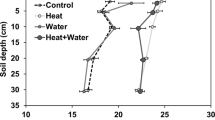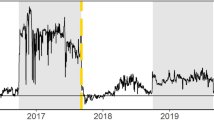Abstract
Aims
Root respiration and its temperature sensitivity (Q10) are key parameters for understanding the processes and mechanisms of carbon cycling in forest ecosystems. However, the variation and influencing factors of root respiration rate and Q10 among soil depths have been poorly explored.
Methods
We measured root respiration rates of the first five orders at 6, 18 and 24 °C, in surface (0–10 cm) and subsurface (20–30 cm) soil layers in six temperate tree species (Fraxinus mandshurica, Phellodendron amurense, Prunus padus, Larix gmelinii, Picea koraiensis and Pinus sylvestris var. mongolica) and calculated their Q10. Concurrently, we determined root morphological and chemical traits and soil properties.
Results
Shallow roots generally exhibited faster respiration rates and higher Q10, which was more prominent in the first two order roots. Respiration rates of the first two orders measured at 18 °C were positively correlated with root diameter, root nitrogen concentration and ambient soil temperature (significant only for the first order), but negatively with root tissue density. By contrast, Q10 values were only significantly correlated with soil temperature on the day of root sampling. Furthermore, according to the conceptual framework of the root economics space, root traits along the “conservation” gradient were mainly affected by soil depth, with shallow roots showing “fast” respiration rates and high nitrogen concentrations.
Conclusions
The systematic variation of root respiration and Q10 between soil depths and among root orders should be considered towards a mechanistic understanding of carbon cycling in forest ecosystems which would shed light on modeling the carbon cycle.





Similar content being viewed by others
Data availability
The data that support the findings of this study are available from the corresponding author upon reasonable request.
References
Apostol KG, Jacobs DF, Wilson BC, Salifu KF, Dumroese RK (2007) Growth, gas exchange, and root respiration of Quercus rubra seedlings exposed to low root zone temperatures in solution culture. Forest Ecol Manag 253:89–96. https://doi.org/10.1016/j.foreco.2007.04.054
Atkin OK, Tjoelker MG (2003) Thermal acclimation and the dynamic response of plant respiration to temperature. Trends Plant Sci 8:343–351. https://doi.org/10.1016/S1360-1385(03)00136-5
Atkin OK, Edwards EJ, Loveys BR (2000) Response of root respiration to changes in temperature and its relevance to global warming. New Phytol 147:141–154. https://doi.org/10.1046/j.1469-8137.2000.00683.x
Atkin OK, Bruhn D, Hurry VM, Tjoelker MG (2005) The hot and the cold: unravelling the variable response of plant respiration to temperature. Funct Plant Biol 32:87–105. https://doi.org/10.1071/FP03176
Bergmann J, Weigelt A, van der Plas F, Laughlin DC, Mommer L et al (2020) The fungal collaboration gradient dominates the root economics space in plants. Sci Adv 6:eaba3756. https://doi.org/10.1126/sciadv.aba3756
Bond-Lamberty B, Thomson A (2010) Temperature-associated increases in the global soil respiration record. Nature 464:579–582. https://doi.org/10.1038/nature08930
Burton AJ, Pregitzer KS, Ruess RW, Hendrick RL, Allen MF (2002) Root respiration in north American forests: effects of nitrogen concentration and temperature across biomes. Oecologia 131:559–568. https://doi.org/10.1007/s00442-002-0931-7
Burton AJ, Melillo JM, Frey SD (2008) Adjustment of forest ecosystem root respiration as temperature warms. J Integr Plant Biol 50:1467–1483. https://doi.org/10.1111/j.1744-7909.2008.00750.x
Chen DM, Zhang Y, Lin YB, Chen H, Fu SL (2009) Stand level estimation of root respiration for two subtropical plantations based on in situ measurement of specific root respiration. Forest Ecol Manag 257:2088–2097. https://doi.org/10.1016/j.foreco.2009.02.018
Chen DM, Zhou LX, Rao XQ, Lin YB, Fu SL (2010) Effects of root diameter and root nitrogen concentration on in situ root respiration among different seasons and tree species. Ecol Res 25:983–993. https://doi.org/10.1007/s11284-010-0722-2
Chen TT, Lin CF, Song TT, Guo RQ, Cai YY, Chen WY, Xiong DC, Jiang Q, Chen GS (2021) Does root respiration of subtropical Chinese fir seedlings acclimate to seasonal temperature variation or experimental soil warming? Agric For Meteorol 308–309:108612. https://doi.org/10.1016/j.agrformet.2021.108612
Cheng WX, Fu SL, Susfalk RB, Mitchell RJ (2005) Measuring tree root respiration using 13C natural abundance: rooting medium matters. New Phytol 167:297–307. https://doi.org/10.1111/j.1469-8137.2005.01427.x
Covey-crump EM, Attwood RG, Atkin OK (2002) Regulation of root respiration in two species of Plantago that differ in relative growth rate: the effect of short- and long- term changes in temperature. Plant Cell Environ 25:1501–1513. https://doi.org/10.1046/j.1365-3040.2002.00932.x
Dannoura M, Kominami Y, Tamai K, Goto Y, Jomura M, Kanazawa Y (2006) Short-term evaluation of the contribution of root respiration to soil respiration in a broad-leaved secondary forest in the southern part of Kyoto prefecture. J Agric Meteorol 62:15–21. https://doi.org/10.2480/agrmet.62.15
Desrochers A, Landhausser SM, Lieffers VJ (2002) Coarse and fine root respiration in aspen (Populus tremuloides). Tree Physiol 22:725–732. https://doi.org/10.1093/treephys/22.10.725
Fu YM, Feng FJ, Fan XX, Hu YB, Zhang XY (2019) Seasonal dynamics of fine root respiration in the degraded and successional primary Korean pine forests in the Lesser Khingan mountains of Northern China. Ecol Indic 102:1–9. https://doi.org/10.1016/j.ecolind.2019.02.029
Gao J, Zhou MY, Shao JJ, Zhou GY, Liu RQ, Zhou LY, Liu HY, He YH, Chen Y, Zhou XH (2021) Fine root trait-function relationships affected by mycorrhizal type and climate. Geoderma 394. https://doi.org/10.1016/j.geoderma.2021.115011
Germon A, Laclau JP, Robin A, Jourdan C (2020) Tamm review: deep fine roots in forest ecosystems: why dig deeper? Forest Ecol Manag 466:1–16. https://doi.org/10.1016/j.foreco.2020.118135
Han MG, Zhu B (2020) Linking root respiration to chemistry and morphology across species. Global Change Biol 27:190–201. https://doi.org/10.1111/gcb.15391
Hanson PJ, Edwards NT, Garten CT, Andrews JA (2000) Separating root and soil microbial contributions to soil respiration: a review of methods and observations. Biogeochemistry 48:115–146. https://doi.org/10.1023/A:1006244819642
Jarvi MP, Burton AJ (2020) Root respiration and biomass responses to experimental soil warming vary with root diameter and soil depth. Plant Soil 451:435–446. https://doi.org/10.1007/s11104-020-04540-1
Jia SX, Wang ZQ, Li XP, Zhang XP, Mclaughlin NB (2011) Effect of nitrogen fertilizer, root branch order and temperature on respiration and tissue N concentration of fine roots in Larix gmelinii and Fraxinus mandshurica. Tree Physiol 31:718–726. https://doi.org/10.1093/treephys/tpr057
Jia SX, McLaughlin NB, Gu JC, Li XP, Wang ZQ (2013) Relationships between root respiration rate and root morphology, chemistry and anatomy in Larix gmelinii and Fraxinus mandshurica. Tree Physiol 33:579–589. https://doi.org/10.1093/treephys/tpt040
Jin NN, Crous KY, Li J, Zineb C, Barton CVM, Arndt SK, Reich PB, Tjoelker MG, Elise P (2020) Does root respiration in Australian rainforest tree seedlings acclimate to experimental warming? Tree Physiol 40:1192–1204. https://doi.org/10.1093/treephys/tpaa056
Lai ZR, Zhang YQ, Wu B, Qin SG, Feng W, Liu JB (2015) Impacts of morphological traits and temperature on fine root respiration during dormancy of Caragana korshinskii. Ecol Res 30:337–345. https://doi.org/10.1007/s11284-014-1227-1
Lambers H, Oliveira RS (2019) Plant physiological ecology, 3rd edn. Springer, Cham. https://doi.org/10.1007/978-3-030-29639-1
Lyons EM, Pote J, DaCosta M, Huang BR (2007) Whole-plant carbon relations and root respiration associated with root tolerance to high soil temperature for Agrostis grasses. Environ Exp Bot 59:307–313. https://doi.org/10.1016/j.envexpbot.2006.04.002
Machado J, Reich PB (2006) Dark respiration rate increases with plant size in saplings of three temperate tree species despite decreasing tissue nitrogen and nonstructural carbohydrates. Tree Physiol 26:915–923. https://doi.org/10.1093/treephys/26.7.915
Maier CA, Kress LW (2000) Soil CO2 evolution and root respiration in 11 year-old loblolly pine (Pinus taeda) plantations as affected by moisture and nutrient availability. Can J Forest Res 30:347–359. https://doi.org/10.1139/cjfr-30-3-347
Makita N, Hirano Y, Mizoguchi T, Kominami Y, Mizoguchi T, Ishii H, Kanazawa Y (2009) Fine root morphological traits determine variation in root respiration of Quercus serrata. Tree Physiol 29:579–585. https://doi.org/10.1093/treephys/tpn050
Makita N, Kosugi Y, Dannoura M, Takanashi S, Niiyama K, Kassim AR (2012) Patterns of root respiration rates and morphological traits in 13 tree species in a tropical forest. Tree Physiol 32:303–312. https://doi.org/10.1093/treephys/tps008
Paradiso E, Jevon F, Matthes J (2019) Fine root respiration is more strongly correlated with root traits than tree species identity. Ecosphere 10:e02944. https://doi.org/10.1002/ecs2.2944
Poorter H, Van der Werf A, Atkin OK, Lambers H (1991) Respiratory energy requirements of roots vary with the potential growth rate of a plant species. Physiol Plant 83:469–475. https://doi.org/10.1111/j.1399-3054.1991.tb00122.x
Pregitzer KS, Laskowski MJ, Burton AJ, Lessard VC, Zak DR (1998) Variation in sugar maple root respiration with root diameter and soil depth. Tree Physiol 18:665–670. https://doi.org/10.1093/treephys/18.10.665
Pregitzer KS, Deforest JL, Burton AJ, Allen MF, Ruess RW, Hendrick RL (2002) Fine root architecture of nine North American trees. Ecol Monogr 72:293–309. https://doi.org/10.2307/3100029
Roumet C, Birouste M, Picon-Cochard C, Ghestem M, Osman N, Vrignon-Brenas S, Cao K, Stokes A (2016) Root structure–function relationships in 74 species: evidence of a root economics spectrum related to carbon economy. New Phytol 210:815–826. https://doi.org/10.1111/nph.13828
Schenk HJ, Jackson RB (2002) The global biogeography of roots. Ecol Monogr 72:311–328. https://doi.org/10.2307/3100092
Shi BK, Jin GZ (2016) Variability of soil respiration at different spatial scales in temperate forests. Biol Fert Soils 52:561–571. https://doi.org/10.1007/s00374-016-1100-1
Subke J, Inglima I, Cotrufo MF (2006) Trends and methodological impacts in soil CO2 efflux partitioning: a metaanalytical review. Global Change Biol 12:921–943. https://doi.org/10.1111/j.1365-2486.2006.01117.x
Trocha LK, Bułaj B, Kutczyńska P, Mucha J, Rutkowski P, Zadworny M (2017) The interactive impact of root branch order and soil genetic horizon on root respiration and nitrogen concentration. Tree Physiol 37:1055–1068. https://doi.org/10.1093/treephys/tpx096
Wang ZQ, Guo DL, Wang XR, Gu JC, Mei L (2006) Fine root architecture, morphology, and biomass of different branch orders of two Chinese temperate tree species. Plant Soil 288:155–171. https://doi.org/10.1007/s11104-006-9101-8
Wang Y, Dong XY, Wang HF, Wang ZQ, Gu JC (2016) Root tip morphology, anatomy, chemistry and potential hydraulic conductivity vary with soil depth in three temperate hardwood species. Tree Physiol 36:99–108. https://doi.org/10.1093/treephys/tpv094
Wang YN, Gao GQ, Wang N, Wang ZQ, Gu JC (2019) Effects of morphology and stand structure on root biomass and length differed between absorptive and transport roots in temperate trees. Plant Soil 442:355–367. https://doi.org/10.1007/s11104-019-04206-7
Wen ZH, White PJ, Shen JB, Lambers H (2022) Linking root exudation to belowground economic traits for resource acquisition. New Phytol 223:1620–1635. https://doi.org/10.1111/nph.17854
Yan H, Freschet GT, Wang H, Hogan JA, Li SG, Valverde-Barrantes OJ, Fu XL, Wang RL, Dai XQ, Jiang L, Meng SW, Yang FT, Zhang MM, Kou L (2022) Mycorrhizal symbiosis pathway and edaphic fertility frame root economics space among tree species. New Phytol 234:1639–1653. https://doi.org/10.1111/nph.18066
Zhao JJ, Gong L (2021) Response of fine root carbohydrate content to soil nitrogen addition and its relationship with soil factors in a schrenk (Picea schrenkiana) forest. J Plant Growth Regul 40:1210–1221. https://doi.org/10.1007/s00344-020-10181-6
Zogg GP, Zak DR, Burton AJ, Pregitzer KS (1996) Fine root respiration in northern hardwood forests in relation to temperature and nitrogen availability. Tree Physiol 16:719–725. https://doi.org/10.1093/treephys/16.8.719
Acknowledgements
We thank Dr Na Wang, Zhi Liu, Siyuan Wang, Hao Ren, Yaoyuan Ma, and Ms. Lijuan Xiao, Xiuxue Xia, Zhendong Ma, for their assistance in field and laboratory works. We also thank Professor Hans Lambers in University of Western Australia for his kind comments and language editing. This study was funded by the National Natural Science Foundation of China (No. 32071749) and by the National Key Research and Development Program of the Ministry of Science and Technology of China (No. 2022YFD2200303).
Author information
Authors and Affiliations
Contributions
JCG, DNW conceived the ideas, DNW, GQG, and SXJ designed methodology; DNW, GQG, and YW collected the data; DNW analyzed the data; DNW and JCG led the writing of the manuscript. All authors contributed critically to the drafts and gave final approval for publication.
Corresponding author
Ethics declarations
Conflict of interest
The authors declare that they have no conflict of interest.
Additional information
Responsible Editor: Timothy J. Fahey.
Publisher's note
Springer Nature remains neutral with regard to jurisdictional claims in published maps and institutional affiliations.
Supplementary Information
Below is the link to the electronic supplementary material.
Rights and permissions
Springer Nature or its licensor (e.g. a society or other partner) holds exclusive rights to this article under a publishing agreement with the author(s) or other rightsholder(s); author self-archiving of the accepted manuscript version of this article is solely governed by the terms of such publishing agreement and applicable law.
About this article
Cite this article
Wang, D., Gao, G., Wang, Y. et al. Temperature sensitivity of root respiration declines with increasing soil depth in six temperate tree species. Plant Soil 492, 315–328 (2023). https://doi.org/10.1007/s11104-023-06176-3
Received:
Accepted:
Published:
Issue Date:
DOI: https://doi.org/10.1007/s11104-023-06176-3




